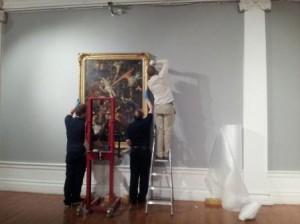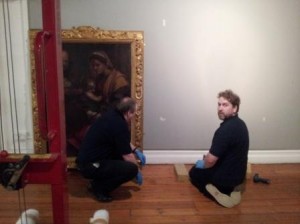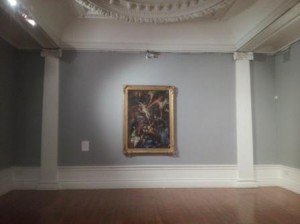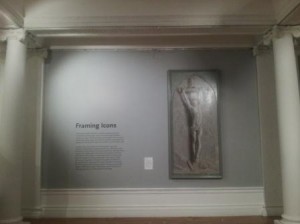“He’s slipped on the right”, I tell a patient Ray and Steve. Nimbly, blue-gloved hands raise the picture edge a fraction higher, straightening a two metre, grisaille Christ. It’s a Friday afternoon at the Hatton, and we are hanging ‘Framing Icons’, the gallery’s new display of Old Master paintings, opening 7th December.
This is the first time for decades that a selection of the Hatton’s beautiful, pre-1800 paintings have been shown in their full glory, the subject of over a year’s careful conservation and reframing.
Hanging 14 paintings and prints, you might think, should be fairly straightforward. Maybe a little more complicated than nailing in a few photo frames or sticking up some posters at home, but surely not a magnificently large task? Hanging even a small display of works, is in fact a rather big job, particularly when some of the paintings are over 600 years old.
Firstly, there is the matter of transport. With fragile frames and surfaces, paintings need to be protected exceptionally well in transit, including being packed and sealed with many layers of protective padding and strapped to the inside of a van, which ideally has ‘air ride’ to stop it from bumping around, and is climate controlled, so that the picture remains in a steady temperature, as quick changes are potentially damaging to these fragile works.
The route that a painting takes must be carefully thought out: even what seems like a small move from a storage location to the gallery requires point-by-point checking that the route is free from obstructions and potential risks, such as swinging doors and dashing students. Equally, the placement of the works needs to be carefully planned; adequate foam padding must be distributed in locations free from disruption and frequent movement, allowing the works to be safely positioned before their transition onto the wall.
The preparation of an exhibition requires key involvement from the conservation team. Careful checks of the paintings must be made before they leave storage, and the same checks made once they reach the gallery space, ensuring that no change to the delicate surfaces has occurred during transit.
Getting the pictures on the walls throws up new challenges. Firstly, there is the immediate task of ensuring that the pictures work well in their layout; for example, if you allow a painting to be hung so the subject is looking into a corner, this may create an unwanted statement about the work. Often, an exhibition can be planned to the last detail on paper, taking into consideration all of the theoretical reasons for hanging paintings in a certain order, but once the pictures are in the space this plan just does not seem to work, and an entirely new layout may have to be devised on the spot.
How high do you hang a painting? If a work was originally intended as an altarpiece, for example, should this effect be recreated by hanging the work high, prompting people to look up as someone may have done centuries ago? Or would it be more beneficial to hang the work lower, allowing people to inspect the beauty and skill behind the design? All of these things need to be decided before the hang takes place.
Another challenge is getting a painting to sit straight on a wall. It is rare that an Old Master painting will be absolutely straight at the edges, and even rarer that a century’s old frame will level off evenly. Equally, the floors, walls and ceilings of old buildings may not be entirely straight, throwing more potential wobble into the situation. So a curator will spend a fair amount of time standing back from an artwork, staring from this angle and that, to see if it appears straight. It seems that this is a skill developed over time, with seasoned curators able to tell a wonky painting at a quick glance.
The weight of an early work, which may have been painted on wood panel, can be a strain on the burliest of art handlers. Often, manual machinery is used to carefully hoist the work to the required height before it is finally screwed into the wall (always with hand tools, never with the potentially uncontrollable power tool). Small platform lifts can be used to elevate an art handler to the required level for handling high paintings. All of these processes take time and require a patient team of art handlers and curators, with plenty of communication at every stage.
Finally, labels and lighting need to be considered. Where do you place the labels: to the left, or to the right of the works? Should it be a consistent rule throughout? Should they be close-by or at a distance? On a practical level, the ‘lux’ levels of light hitting works on paper can not be as high as those on a painting due to conservation reasons. Aesthetically, the effect of a spotlight on a painting can be dramatic, and could create an emphasis that isn’t necessarily intended.
Of course, these details may be worries occupying the mind of the curator alone. Perhaps the best sign that an exhibition is doing a good job is when a visitor simply does not notice these details, transfixed instead by the magnificent paintings on show.
Framing Icons opens Friday 7th December 2012, and runs until February 2013.





3 Responses to Framing Icons: Hanging Old Masters